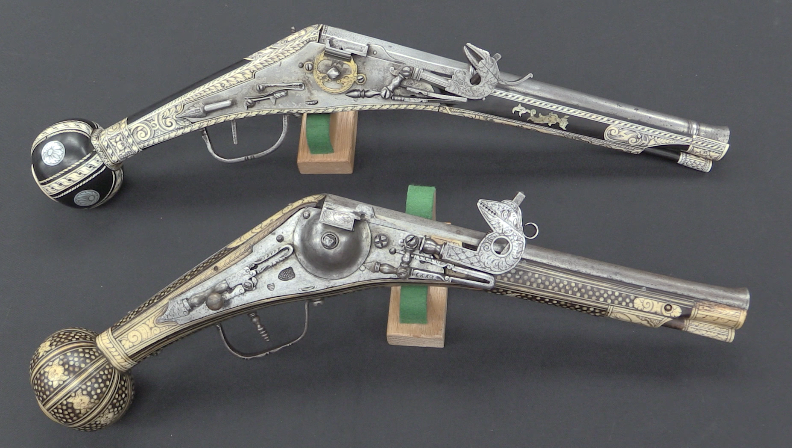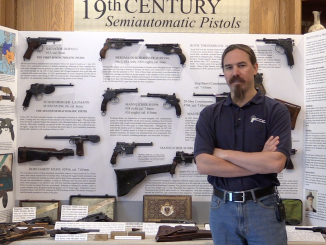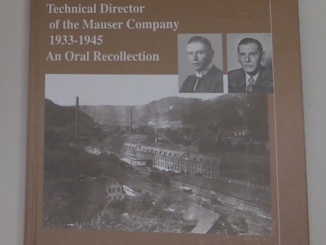The first iteration of the iconic German Sturmgewehr was developed by Haenel starting in 1938. It was a select-fire rifle chambered for the short 8x33mm cartridge, developed by the Polte company. It used a long-stroke gas piston and a tilting bolt patterned after the Czech ZB-26 light machine gun. What makes the MKb42(H) stand out from the later Sturmgewehr models is that it was an open-bolt design. The original design spec was concerned about preventing cook-offs, and so it required firing from an open bolt. This means a very simple fire control system, but it also made the rifle difficult to shoot accurately in semiautomatic.
The first MKb42(H) prototype was finished in 1941, with 50 sample guns produced by late March 1942. A major trials was held inApril 1942, in which Hitler rejected the design (mostly, he disliked the smaller cartridge). Development was continued anyway, with a move to a closed-bolt system that would become the MP43/1 which was ready for its first testing in November 1942. The open-bolt 42(H) was put into production anyway, as a stopgap measure to provide some much-needed individual firepower to troops on the Eastern front. Serial production began in January 1943, and continued until September 1943. In total, 11,813 of the rifles were manufactured. They saw use in Russia until replaced by newer MP43 models, and represent the first combat use of the assault rifle concept.
Video on the MKb42(W):
Did Hitler cancel the Sturmgewehr?




“(…)troops on the Eastern front(…)”
There some specimens were captured and investigated, which resulted in reports
https://www.tankarchives.ca/2018/03/mkb-42h-first-appearance.html
https://www.tankarchives.ca/2019/09/even-more-mkb-42h-intel.html
What is interesting is presumed magazine capacity from 2nd one
The machinegun is fed from detachable double feed 35-38 round magazines.
that is noticeable more than 30.
I would hazard a guess that the poor bastards that were tasked with doing that technical intelligence were working off of damaged weapons and magazines, and without enough ammo to fully fill a magazine.
Alternatively, the 35-38 round count is a typo, which is another commonplace thing to find in such documents during that era. Look at all the errors in the US technical intelligence stuff about German small arms for examples…
I’m actually pretty impressed that they got all that they did… For something that was a battlefield pickup, those drawings and technical inferences are pretty damn good. Dimensionally accurate, so far as I can tell, and carefully reasoned. A mistake or two of a minor nature like magazine capacity is far outshadowed by the rest of it they have there.
“He’s still gripping it quite tightly Sir, and it’s cold out.” Cough, here… A Swiss Army knife. “You mean?” Yes, it has implements to assist; a corksrew, nail file et al. We need the gun. “Ok, I see.”
I learned a lot from this.
I had thought that the design tapped gas from the end of the barrel, like a Garand, which was not the case.
I was also unaware it was an open bolt design. It was a very simple rifle, the Germans would have been wise to have mass produced it. Luckily they did not.
I think the accuracy problems of an open bolt design are a bit overblown. Technically, yes, it would be less accurate than a closed bolt design. But it would probably still be more accurate than most of the men using it, especially in the heat of battle. I accept that ingress of dirt might have been a problem, but in the context of the Eastern Front, an acceptable risk, as set against getting an assault rifle into the hands of the troops.
“(…)very simple(…)”
I must warn you that according to http://modernfirearms.net/en/assault-rifles/germany-assault-rifles/mkb-42h-42w-42g-eng/
The new weapon had to be made with the maximum utilisation of stamping and welding, in order to make it more affordable to manufacture and reduce the use of rapidly depleting resources. So Haenel was joined by the Metz-Werke company. This company had no knowledge of the manufacture of firearms but a great deal of experience in steel stamping and forming.
which raises question about relation of said Metz-Werke to German arms makers. Were they happy with new methods or would be more pleased with keeping old methods in use?
There is a simplified STG model of 1945, M.Heidler wrote about it, I would really like to see Ians vid on it one day.
It uses squareish simplistic receiver compared to all this, that pivots open like in AR18 and similar rifles.
This open bolt actually is more controllable in longer burst full auto fire.
From the large April 1943 troop trials, the reports by 24 divisions and some regiment size units are available in the German Militärarchiv. At least 6458 weapons were issued, mostly of the open bolt version.
Not all reports, but a large majority expressed the need to fire aimed sinle shots and did not consider the open bolt version being precise enough in this mode.
This remained the practice to the end of the war (field manual 1944): aimed single shots being the standard. Bursts were limited to close combat.
There was comparison-test run in Soviet Union against M1 Carbine
https://www.tankarchives.ca/2018/03/the-precision-of-mkb-42h-at-ranges-of.html
The precision of the MKb 42(H) at ranges of 100, 300, and 500 meters is 1.5 times worse than that of the American M1 carbine.
In automatic fire, the precision of the MKb 42 (H) is unsatisfactory (a burst doesn’t fall inside a 1.5 x 1.5 meter target at 100 meters).
The reliability of the automatic mechanism has not been determined.
The design of the sample is complex, but the widespread use of stamped parts deserves attention.
I don’t think the Soviet idea of full-auto accuracy was entirely all that well thought-out, TBH. 1.5X1.5m targets at 100m? That’s more a standard for something fired off a tripod, like an MMG.
Typical combat usage for something like a submachinegun or assault rifle would be “full auto at under 50m”, in that you’re only going to be using that as a close-in suppressive fire mode during final defense or assault. The rest of the time, you should be on semi, using aimed deliberate shots at identified targets. And, if you’re just doing the “suppressive fire, bang bang bang” thing, who the hell really cares if you hit some explicit target? You’re probably not really aiming anyway; you’re merely trying to keep heads down while you make a run for it.
This is one of the things about Soviet/Russian mania for full-auto fire that just leaves me baffled; the apparent intent is for them to produce these individual weapons that can be fired accurately on fully-automatic at some deliberately identified target, as if the rifleman is going to be able to calmly and rationally pick and choose what the hell he’s shooting at under those conditions… I don’t think the tactical case can be made for that crap, when you get down to it. Not to the point where something like the AN-94 or the balanced-recoil AKs are worth the effort.
The parallel American obsession with the usual uber-Individual Marksman BS is equally baffling; combat does not work like that, not these days. Individual weapons are for the close-in fight, the one where you’re having to spend rather more time identifying and obtaining the close-in target; it is not the place for something that handles like a sniper rifle and/or indiscriminately sprays projectiles around like a hose. You need something handy, something relatively light, and able to be shifted from target to target as they present themselves.
Both the American and Soviet/Russian approaches are apparently based on doing the jobs/targets that ought to properly be given to the machine gun, grenade launcher, and mortar. It’s purest delusion about how things really work, down at the coalfaces of modern combat.
It’s also crazed that they’re trying to do with the individual weapon what is being done with the drone, currently. I think there’s going to be a “great awakening” the next time the US goes to war, with the NGSW being rapidly pushed out in favor of the M4A1. I can see a few being kept around as DMR-role weapons, but that’s it.
What was the MKb42 being compared with? A Kar98k? Of course it is less accurate. How can an open bolt assault rifle be more accurate than a bolt action? But pure accuracy is not the point of an assault rifle is it? In action, will a soldier really notice the difference between an open bolt and a closed bolt? He will notice the fact he is able to put a lot more rounds downrange at the enemy than he ever could with a bolt action, with a lot less recoil.
Is there any evidence that the soldiers evaluating the Kb42 knew about the philosophy behind it? Or were they just saying that at 300m it was less accurate than a Mauser 98? Well yes, of course it is, but that’s not the point.
What individual weapon should a German infantryman on the Eastern Front in 1943 have been using as a comparison instead of his K98k?
Exactly. The Germans were comparing apples with oranges. Of course an Mk42 is not as accurate as a Kar98k, but that is not the point. The Germans had just invented the assault rifle, so it is not surprising the troops in Russia, or rather their officers, did not know how to evaluate it. If it had to be compared to anything, it should have been the MP40. But I cannot blame them for the confusion. Things which seem obvious now would not have been at the time.
@JohnK,
I think you’re missing the point, here. I rather doubt that the Soviets were testing German weapon against German weapon, and since they were doing the testing, I’d have to assume they were comparing them directly to their own weapons.
Which means, more than likely, that the control weapons in this case were PpSh-41/43 SMGs and the Mosin 1931/30 rifles.
I can’t find any more details on that testing, so I can’t tell you for sure. I rather doubt that they’d be doing comparative testing for German weapons, however… That’d make very little sense.
Kirk:
I was thinking of the evaluations the German forces on the Eastern Front were doing on the Mk42.
I can sympathize with them, because it was a new concept, so what would they compare it to?
I had not known it was an open bolt design, but equally, I doubt that is all that important in the grand scheme of things. They were not designed for snipers after all. But they were easier to use than a Kar98k. I think if the Germans had had the nerve to put the Mk42 into full production they would not have regretted it. The increase in effective firepower for their infantry sections would have been considerable. However, I can quite understand why this did not happen.
Grandson of the Chauchat.